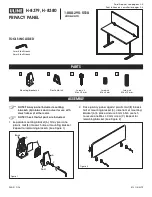Lexicon
300 V 3.0 Owner's Manual
4-2
The 300 incorporates the results of a great deal of research into acoustics and
reverberation. Reverberation, or reflected sound energy, gives recorded music
a sense of being performed in a real acoustic location.
In the 300, the SIZE, SPREAD and SHAPE controls allow adjustment of the
buildup and decay of the initial part of the reverberation envelope. SHAPE
controls the shape of the envelope, while SPREAD and SIZE set the time over
which this shape is active.
In the Random Hall program, SIZE acts as a master control for the apparent size
of the space being created by the 300. Both SPREAD and RTIM vary
linearly
with the setting of SIZE. Thus maximum reverb time and spread require high
settings of SIZE. To find an appropriate reverb sound, start with a preset with a
similar sound to what you want to end up with. Simply varying SIZE is often
sufficient to arrive at the exact sound you are seeking.
Once a size has been selected, SPREAD and SHAPE are used to adjust the
shape and duration of the initial reverb envelope, which together provide the
major sonic impression of room size.
When SHAPE is at minimum, the reverberation envelope builds up very quickly
to a maximum amplitude, and then dies away quickly at a smooth rate. This
envelope is characteristic of small reverberation chambers and reverberation
plates. There are few (if any) size cues in this envelope, so it is ineffective in
creating ambience. With this SHAPE setting, SPREAD has no effect. The
density is set by the size control, and the rate of decay is set by RTIM. This
reverberation envelope is typical of many of the popular digital reverberators of
the last few years.
As SHAPE is raised to about 1/8 of its range, the initial sharp attack of the
reverberation is reduced, and reverberation builds more slowly. The envelope
then sustains briefly before it begins to die away at the rate set by RTIM.
SPREAD has little or no effect on this shape.
When SHAPE is at 1/4 of its range, buildup is even slower and the sustain is
longer. Now SPREAD affects the length of both the buildup and the sustain. As
a rough estimate, the sustain will be approximately the time value indicated by
the SPREAD display (in milliseconds).
As SHAPE is raised further, the buildup and sustain remain similar, but now a
secondary sustain appears in the envelope, at a lower level than the first. This
secondary plateau simulates a very diffused reflection off the back wall of a hall,
and is effective in creating a sense of size and space. This reflection becomes
stronger and stronger, reaching an optimal loudness when SHAPE is at about
1/2 of its range.
The highest SHAPE settings are typically used for effects. Near the top of the
scale the back wall reflection becomes stronger than the earlier part of the
envelope, resulting in an inverse sound.
General Description
Single Setup
Algorithms
Random Hall
Summary of Contents for 300
Page 1: ...300 Digital Effects System V 3 0 Owner s Manual ...
Page 6: ......
Page 9: ......
Page 10: ...1 1 Installing the 300 1 Installing the 300 ...
Page 21: ...2 1 System Overview 2 System Overview ...
Page 30: ...3 1 System Operation 3 System Operation ...
Page 57: ...4 1 The Algorithms and their Parameters 4 The Algorithms and their Parameters ...
Page 93: ...5 1 The Presets 5 The Presets ...
Page 129: ...6 1 Time Code Operation 6 Time Code Operation ...
Page 139: ...7 1 MIDI Operation 7 MIDI Operation ...
Page 147: ...8 1 Troubleshooting 8 Troubleshooting ...


















